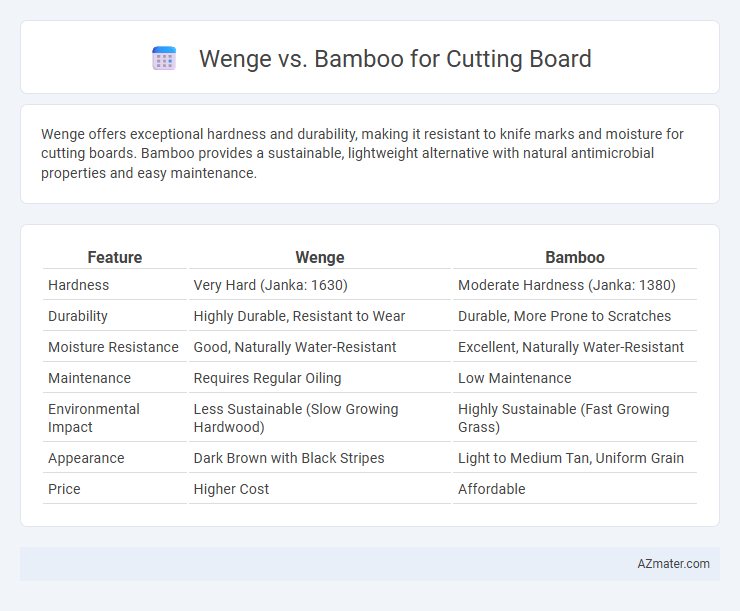Wenge offers exceptional hardness and durability, making it resistant to knife marks and moisture for cutting boards. Bamboo provides a sustainable, lightweight alternative with natural antimicrobial properties and easy maintenance.
Table of Comparison
| Feature | Wenge | Bamboo |
|---|---|---|
| Hardness | Very Hard (Janka: 1630) | Moderate Hardness (Janka: 1380) |
| Durability | Highly Durable, Resistant to Wear | Durable, More Prone to Scratches |
| Moisture Resistance | Good, Naturally Water-Resistant | Excellent, Naturally Water-Resistant |
| Maintenance | Requires Regular Oiling | Low Maintenance |
| Environmental Impact | Less Sustainable (Slow Growing Hardwood) | Highly Sustainable (Fast Growing Grass) |
| Appearance | Dark Brown with Black Stripes | Light to Medium Tan, Uniform Grain |
| Price | Higher Cost | Affordable |
Introduction to Wenge and Bamboo Cutting Boards
Wenge cutting boards, crafted from dense, dark hardwood native to Central Africa, offer exceptional durability and resistance to knife marks, making them ideal for heavy kitchen use. Bamboo cutting boards, made from fast-growing, sustainable grass, provide a lightweight and eco-friendly option with natural antimicrobial properties and lower maintenance requirements. Both materials excel in longevity and hygiene, but Wenge's hardness surpasses bamboo's softer, more flexible surface, offering distinct advantages depending on cooking needs.
Material Origins and Sustainability
Wenge, sourced from the dense hardwood of the Millettia laurentii tree native to Central Africa, offers exceptional durability and natural antimicrobial properties suitable for cutting boards. Bamboo, a rapidly renewable grass mainly grown in Asia, provides a sustainable alternative due to its fast growth rate and minimal environmental impact during harvesting. Choosing bamboo promotes eco-friendly practices by reducing deforestation, while wenge's extraction requires careful management to prevent habitat depletion and support conservation efforts.
Durability and Hardness Comparison
Wenge offers superior hardness with a Janka rating of approximately 1630, making it extremely resistant to knife marks and scratches, while bamboo's hardness varies between 1200 and 1380, depending on its processing method. In terms of durability, wenge is dense and naturally oily, providing excellent resistance to moisture and warping, whereas bamboo, though harder than many hardwoods, is more prone to splitting and requires careful maintenance to prevent damage. Choosing wenge ensures longer-lasting performance in demanding kitchen environments, whereas bamboo offers sustainable benefits but may need more frequent replacement.
Cutting Surface and Knife Friendliness
Wenge cutting boards offer a dense, closed-grain surface that resists deep knife marks, preserving the cutting board's longevity but may cause faster dulling of knife blades due to its hardness. Bamboo cutting boards feature a hard yet slightly flexible surface composed of natural fibers that provide a balance between durability and knife friendliness, reducing blade wear while maintaining a smooth cutting experience. Both materials are sustainable options; however, bamboo's softer surface typically ensures less frequent sharpening for knives compared to the tougher wenge wood.
Maintenance and Cleaning Requirements
Wenge cutting boards require regular oiling with mineral oil to prevent drying and cracking, and their porous surface demands thorough cleaning after each use to avoid staining and odor retention. Bamboo boards are less porous and more resistant to moisture, making them easier to clean with mild soap and water, while occasional oiling is sufficient to maintain their smooth finish. Both materials should be hand-washed and dried immediately to prolong their lifespan and prevent warping.
Resistance to Stains and Odors
Wenge cutting boards exhibit superior resistance to stains and odors due to their dense, tight grain structure and natural oils that repel moisture and contaminants. Bamboo cutting boards, while eco-friendly and hard, tend to absorb liquids more readily, making them more susceptible to staining and retaining odors from strong foods. Choosing wenge enhances durability and cleanliness in kitchen use, especially for preparing pungent ingredients like garlic or onions.
Aesthetics and Kitchen Compatibility
Wenge cutting boards offer a rich, dark brown color with fine, straight grain patterns that provide a sophisticated and modern look, ideal for contemporary kitchens with darker or high-contrast color schemes. Bamboo cutting boards boast a light, natural golden hue with a smooth, uniform texture that complements minimalist or rustic kitchens, blending well with lighter countertops and wooden kitchen elements. Both materials resist stains and scratches effectively, but Wenge's dramatic appearance makes it a striking centerpiece, while bamboo's warm tone enhances cozy and inviting kitchen atmospheres.
Price Differences and Value
Wenge cutting boards are generally more expensive than bamboo due to Wenge's dense, hardwood nature and limited availability, which adds to its durability and resistance to knife marks. Bamboo boards offer excellent value with affordable pricing, eco-friendliness, and sufficient hardness suitable for most kitchen tasks. While Wenge provides longer-lasting performance, bamboo balances cost-effectiveness and sustainability for everyday use.
Eco-Friendliness and Environmental Impact
Wenge cutting boards come from slow-growing African hardwoods, raising concerns about deforestation and habitat loss, while bamboo boards are made from rapidly renewable grasses that regenerate quickly with minimal environmental disturbance. Bamboo's rapid growth rate and natural pest resistance reduce the need for harmful pesticides and fertilizers, making it a more sustainable and eco-friendly choice. The production of bamboo cutting boards typically requires less energy and water compared to hardwoods like wenge, contributing to a lower overall carbon footprint.
Final Verdict: Which Cutting Board Is Best?
Wenge cutting boards offer exceptional hardness and durability, making them highly resistant to knife marks and warping, while bamboo boards provide a sustainable, lightweight, and naturally antimicrobial option. Bamboo's eco-friendly nature combined with its easy maintenance makes it ideal for everyday kitchen use, but Wenge excels in long-term resilience and aesthetic appeal. The best cutting board choice depends on prioritizing either sustainability and lightness with bamboo or durability and luxury with Wenge.

Infographic: Wenge vs Bamboo for Cutting Board
 azmater.com
azmater.com